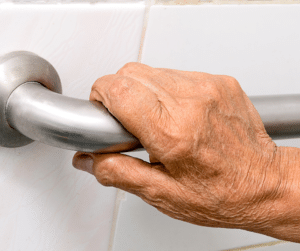Bathrooms — Safety First: Preventing Falls When Aging in Place

As we grow up into our second life and become retired or semi-retired, we may notice that simple tasks like navigating the bathroom can become more challenging and potentially hazardous. We tend to do a great job at compensating as we go, but eventually, it becomes obvious that it should be easier and safer!
Knowing some of the more common locations where injuries occur as we age at home, is important for future proofing, and allowing us to prepare for Home Modifications to help us thrive. For example, the bathroom is one of the most common places for falls among seniors and baby boomers. This is due to wet surfaces and the need to move around in a more confined space.
However, we can significantly reduce the risk of falls in this area with preparation. Regularly inspecting the bathroom for potential hazards and making necessary adjustments can create a positive experience.
Let’s explore some practical tips below!
Install Grab Bars and Handrails
It’s usually a tolerable cost, and high impact when we install grab bars. Grab bars provide stable support when entering and exiting the bathtub or shower and when using the toilet.
It’s important to install these fixtures correctly, ensuring they are securely fastened to the wall and can support the weight of the user. Consider placing grab bars near the toilet, bathtub, and shower for maximum accessibility. You can consult with experts to ensure that the placement is personalized and not a general suggestion like ADA.
Use Non-Slip Mats
Slippery surfaces in the bathroom can increase the risk of falls, especially when wet, and gravity is NOT forgiving. Place non-slip decals on the bathroom floor, inside the bathtub or shower, and even near the sink to provide traction and reduce the likelihood of slipping. Look for mats with a textured surface and a non-slip backing for added safety.
Improve Lighting
Proper lighting is essential for preventing falls in the bathroom, especially during nighttime trips. Ensure that the bathroom is well-lit, with adequate lighting over the bathtub or shower, toilet, and sink areas. Consider installing motion-activated lights that turn on automatically when someone enters the room, providing instant illumination without the need to fumble for a light switch.
Consider a Walk-In Shower
Traditional bathtubs can be difficult for seniors to navigate due to the high step-in height. Consider replacing the bathtub with a walk-in shower that has a low threshold for easy access. Avoid the built-in seats. Occupational Therapists will tell you that the built-in seats are often misplaced or become slippery when wet. Both of these issues can make it even more difficult to bathe confidently as we age. Instead, choose a stand-alone chair when possible. Customize these to your height, weight, and even your aesthetic!
Walk-in tubs can have some benefits and we suggest you check out this blog post from Retirement Living for more information on pros/cons.
Keep Essentials Within Reach
Arrange the bathroom layout so that essential items like toiletries, towels, and toilet paper are within easy reach. Avoid placing items on high  shelves or in cabinets that require reaching or stretching, as this can increase the risk of falls. Consider using wall-mounted shelves or organizers to keep items accessible without cluttering the floor space.
shelves or in cabinets that require reaching or stretching, as this can increase the risk of falls. Consider using wall-mounted shelves or organizers to keep items accessible without cluttering the floor space.
Creating a safe and accessible bathroom while you age in the place you call home is essential for preventing falls and ensuring continued independence and well-being.
By implementing these simple tips, you can significantly reduce the risk of accidents and make the bathroom a safer place.
Stay tuned for the next part of our series, where we’ll explore other safety tips for older adults to prevent falls in another high-risk areas inside and outside the home.
Contributed by:
 Dawn Heiderscheidt OTR/L, ECHM, CAPS
Dawn Heiderscheidt OTR/L, ECHM, CAPS
As a seasoned Occupational Therapist with years of experience in traditional healthcare settings, Dawn is passionate about helping people live independently in their own homes. She turned that passion into a successful mobile home modifications business when she founded Aurora Independence, leveraging her expertise in home modifications and Universal Design to help clients Age in place.
Dawn is the Owner/Founder of Aurora Independence: “Empowering your independence, enhancing your home.”
Dawn’s approach is client-centered and evidenced-based, ensuring that every project is personalized to the unique needs of her clients. She provides home accessibility and home safety consulting on construction projects, additions, and other modifications advocating for proper accessibility at every stage to ensure a safe and comfortable living environment.
Dawn’s drive to help the Aging in Place market is rooted in their personal experience of caring for her parents, her background as a rehab professional, and her own experience navigating the healthcare spaces. Her empathy and dedication to her clients are matched only by her expertise.
She shares this expertise as s guest speaker on entrepreneurship at the university level as a national continuing education provider for fellow healthcare and remodeling professionals.
At Aurora Independence, Dawn’s passion for empowering independence is more than just a business — it’s a way of life.
The Friends Life Care eMeetinghouse blog is a way to share useful aging in place information with older adults. It has a focus on prevention, wellness, home accessibility, and care coordination. Friends Life Care is a Quaker value based nonprofit with a mission to help older seniors and baby boomers— especially Friends Life Care members — age well. If you have questions about Friends Life Care membership, contact one of our Plan Counselors to learn more.
If you are a current member, you can reach out directly to your dedicated care coordinator.
Leave a Comment
